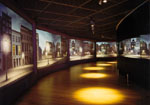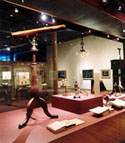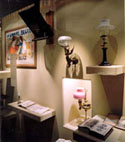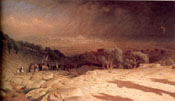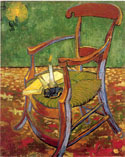The browser will either open the file, download it, or display a dialog.
|
"Light! The Industrial Age 1750–1900: Art & Science, Technology & Society" Andreas Blühm and Louise Lippincott |
||||||
| Even if you were unable to attend this exhibition at the Van Gogh Museum in Amsterdam (figs. 1–4) or the Carnegie Museum of Art in Pittsburgh, its accompanying catalogue is a marvelous book to read. Andreas Blühm, the head of Exhibitions and Display at the Van Gogh Museum, and Louise Lippincott, curator of Fine Arts at the Carnegie Museum, take on the wide-ranging topic of conceptions of light in the arts, society, and culture of the eighteenth and nineteenth centuries in Europe and America, and they write about it with original and unusual insights. Integrating discussions of painting, sculpture, drawings, prints, posters, photographs, advertisements, decorative objects, books, and periodicals with a review of contemporary scientific and technological instruments, theater paraphernalia, domestic lamps, and optical toys, the book presents a fascinating interdisciplinary and transnational account of the visual culture of light. | ||||||
| The refreshing enthusiasm the authors bring to their topic is communicated with lively writing that will engage the general public and scholars alike. Of the nineteenth-century oil lamp, for example, they ask: "Can the experience of its light be visualized best through the emotionally-charged scene in Degas's Interior, or Charles Dickens's description of a cozy evening gathering, or a household manual with instructions for cleaning and filling oil lamps, or by lighting a real antique lamp in a museum laboratory? Our response is an emphatic 'All of the above'" (p. 14). In addition to daylight, in all its shaded manifestations, Blühm and Lippincott explore a chronological as well as thematic progression from candle and oil lamp to gas and electric light and on to the X ray, stopping for fireworks along the way. The trajectory from dim to glowing to dazzling to invisible light is mapped on streets and in fields, shops, homes, factories, battlefields, laboratories, lighthouses, theaters, studios, department stores, cafés, galleries, and museums. | ||||||
| The authors' chosen chronology begins in the middle of the eighteenth century, with the Enlightenment and with public awareness of scientific discoveries about light that had begun in the previous century. It continues into an era of positivism, when the public "believed that science and industry would improve the lot of humanity everywhere" (p. 12). It ends with Einstein's development of relativity theory, which "suddenly removed science and light from the realm of the mundane and placed them in the strange and exotic universe that we struggle to imagine today" (p. 12). A chronology at the end of the book spans 1675 to 1905 and integrates pertinent developments in the areas of science, technology, commerce, and culture. | ||||||
| Light! begins with a thematically arranged essay followed by entries that are roughly chronological, but this organization has a few glitches. It is often impossible to tell which illustrations correspond to objects that were in the exhibition and which are ancillary; one has to flip continually between text and the exhibition checklist at the back. Moreover, entries with complete provenance and bibliography seem to be out of fashion in this and other recent catalogues; this is perhaps a matter of funding and fashion, but catalogues are becoming less useful to scholars because of it. The impressive bibliography (in five or six languages) is subdivided by topic—science and history of science, social history and history of technology, history of lighting, and so forth—which is great when one is consulting the bibliography as an interdisciplinary resource but which can make it difficult to locate references mentioned in the endnotes. A glossary would have been helpful, coordinated between essay and entries, to define frequently used terms such as "limelight," "cliché-verre," "heliostat," "lithophane," "magic lantern," and "arc lamp," the last a term used frequently yet not defined until page 184. The authors acknowledge early on that they are not addressing color as a phenomenon closely aligned with light (p. 13), and whereas the camera obscura and photography (which might have been given a rather more extended discussion) are incorporated, the camera lucida is mentioned only in passing. | ||||||
| These shortcomings are more than compensated for by original research (in both primary and secondary sources) and by a well-conceptualized argument that is readable and intellectually engaging. The authors largely succeed in their declared intention, namely "an attempt to recreate, for today's audiences, lights of an earlier time that illuminate masterpieces of the past" (p. 11). The comparative methodology employed is based in art history as the authors explore old forms of light, how it was experienced in the past, and the degree to which it was represented in art. Artists discussed include Angrand, Bartholdi, Blake, Bernard, Bierstadt, Bonvin, Carrière, Chardin, Church, Constable, Decamps, Degas, Friedrich, Gérôme, Girodet, Van Gogh, Goya, Holman Hunt, Homer, Kollwitz, Loutherbourg, Manet, Martin, von Menzel, Monet, Peto, Pissarro, Redon, Rosso, Segantini, Seurat, Signac, Steinlen, Tissot, Toulouse-Lautrec, Turner, Valenciennes, Vallotton, Whistler, and Wright of Derby; photographers include Daguerre, Fox Talbot, Niépce, among others. But the point is not to compare works of art to each other; the point is to compare "art with experience: the experience of light—how we see it, how they saw it, and how they portrayed it" (p. 13). In their multifaceted approach, the authors admit to feeling a productive kinship with something older than art history: "In the eighteenth and nineteenth centuries, lectures, demonstrations, and exhibitions jumbled together the new science, the new technologies, and sometimes—often unwittingly—new art, for the enlightenment and entertainment of the general public. We are attempting to do the same" (p. 14). The spirit of Wright of Derby lives. | ||||||
|
The interdisciplinary scope of topics includes history of technology, history of science, and popular science including astronomy, social and class history, politics, philosophy, art, prisms, kaleidoscopes, telescopes, microscopes, volcanoes, lightning, searchlights, silhouettes, shadow plays, mirrors, dioramas, and early cinema. Discussions can range from philosophies of the Enlightenment or Freemasonry to the meanings of the lighting along the streets of Paris during the French Revolution or under Haussmannization. (In the case of the entry on street lamps during the Revolution, one wonders why Jean-Paul Marat's intriguing book Découvertes sur la lumière [second edition, 1780], which is listed in the bibliography, is not mentioned in the text.) Other discussions range from the light of God's truth (Lantara's The Spirit of God Moved upon the Face of the Waters, 1751, Musée de Grenoble, and Gérôme's Golgotha, ca. 1868 [fig. 5], Van Gogh Museum) to the light of learning to the light of industry. Loutherbourg's Coalbrookdale by Night, 1801 (Science Museum, London), for example, is described as marking "the passage of power from gods, to kings, to the middle-class industrialists who would dominate the nineteenth century" (p. 90). | |||||
| Along the way, we learn that Girodet's Pygmalion, 1785 (Musée du Louvre) was evidently the first documented painting to have been executed under artificial light (probably an Argand oil lamp directed with the help of reflectors; p. 108). We hear about the lighting of world's fairs, the Paris Salon, the Paris Hippodrome, Wagner's theater at Bayreuth, the South Kensington Museum in London, and the Carlsberg Glyptotek in Copenhagen. We are asked to ponder such excellent questions as why the plein-air effects of Ford Maddox Brown and Corot are so remarkably different, and how Degas's Interior, 1868–69 (Philadelphia Museum of Art), subverted the sentimental and moral meanings of lamp and hearth as conventional, domestic centers of the family circle (pp. 143, 154). We learn that in his painting of Gauguin's Chair, 1888 (fig. 6; Van Gogh Museum), Van Gogh depicts one of the brand new gas jets that he mentioned, in a letter of October 1888, as having just had installed in the Yellow House in preparation for Gauguin's arrival so that they could paint at night; and we are duly provided with a color photograph of the painting seen by gaslight, which reduces the cool colors and enhances the warm ones (pp. 202–3). It is suggested to us that the green sky in Van Gogh's The Sower, 1888 (Van Gogh Museum) can be linked to light phenomena specific to the south of France. The enlarged sun may likewise be related to the "moon illusion," in which the rising moon or setting sun appears much larger when close to the horizon. The unusual bluish and lavender tones of the landscape may result from something called the "Purkinje shift," a phenomenon related to the gradual brightening or darkening of one's surrounding environment: "During the half-hour period while the retina adjusts between reliance on its cones (for daylight vision) to its rods (for night vision), its ability to perceive tones in the blue range increases significantly" (p. 198). Even though this sensitivity to twilight effects does not explain—and might even discount—the artist's expressionism and symbolism (the religious nature of the latter having been recently discussed by Debora Silverman in Van Gogh and Gauguin: The Search for Sacred Art [New York: Farrar, Straus and Giroux, 2000]), it nonetheless attests to a materialist and perceptual attention to nature. One is actually rather amazed that the authors have managed to say something new about Van Gogh. Granted, they occasionally get a detail wrong (p. 224: Monet is said to have completed the Rouen Cathedral series in Paris, not Giverny). Attempts to map the ideological and political implications of light occasionally lead to overgeneralization. An entry on Toulouse-Lautrec's At the Moulin Rouge, 1894–95 (Art Institute of Chicago), for example, states that "Throughout the nineteenth century, gaslighting was the hallmark of working class leisure, culture, and vice" (p. 190), as though the middle classes never utilized it. Nevertheless, one appreciates their attention to the meanings of light for the working classes and for socialists (p. 38). | ||||||
| This is a book that asks the right kinds of questions and does so with a considerable amount of critical self-awareness and some welcome self-deprecating humor. Citing their unexpected comparison of Van Gogh's 1886 painting of a stuffed bat (Van Gogh Museum, Amsterdam) with an orange bat lamp, ca. 1900, by Emile Gallé (Collection Neumann, Gingins, Switzerland), the authors admit, "Our method may be conservative, but our comparisons are somewhat mad" (p. 13). Describing their reliance on relevant popular scientific sources to which artists would have had ready access, they wryly observe that "intertwining art and science has become trendy among art historians, notorious for their antipathy to higher mathematics and the hard sciences" (p. 16). | ||||||
|
One of the strengths of the book is that it connects with today's mundane technological culture:
The authors humbly and wittily admit that the book and exhibition were created on computers whose "software incompatibilities, e-mail viruses, and hardware upgrades hampered the planning and production process every step of the way" (p. 40), and they sympathize with the "housewives who had to retrain themselves when gas pipes replaced oil lamps in the home in the 1850s." They recognize the bewilderment of early exposition visitors, envy the foresight of the capitalists who bet on the new technologies, and "cheer for the artists who invented new painting techniques that would succeed whatever the technology that lit them, and that would show the world in its constantly changing lights" (p. 40). Though some scholars might quibble over individual points in it, Light! remains one of the rare recent catalogues that succeeds in conveying a sense of wonder. |
||||||
| Marilyn Brown Professor of Art History Tulane University New Orleans, Louisiana marilynb@tulane.edu |
||||||


